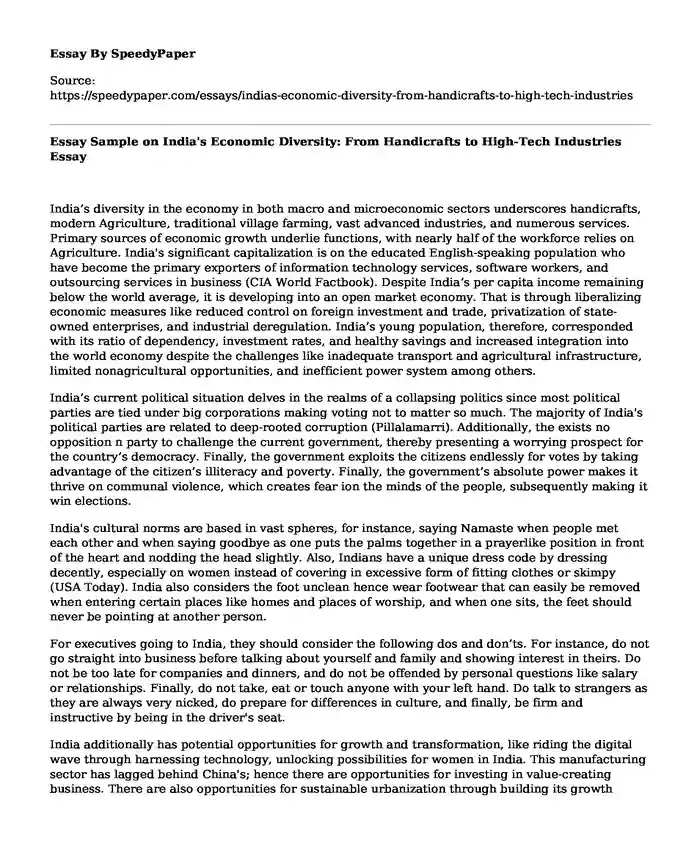
| Type of paper: | Essay |
| Categories: | Economics Technology India |
| Pages: | 3 |
| Wordcount: | 662 words |
India’s diversity in the economy in both macro and microeconomic sectors underscores handicrafts, modern Agriculture, traditional village farming, vast advanced industries, and numerous services. Primary sources of economic growth underlie functions, with nearly half of the workforce relies on Agriculture. India's significant capitalization is on the educated English-speaking population who have become the primary exporters of information technology services, software workers, and outsourcing services in business (CIA World Factbook). Despite India’s per capita income remaining below the world average, it is developing into an open market economy. That is through liberalizing economic measures like reduced control on foreign investment and trade, privatization of state-owned enterprises, and industrial deregulation. India’s young population, therefore, corresponded with its ratio of dependency, investment rates, and healthy savings and increased integration into the world economy despite the challenges like inadequate transport and agricultural infrastructure, limited nonagricultural opportunities, and inefficient power system among others.
India’s current political situation delves in the realms of a collapsing politics since most political parties are tied under big corporations making voting not to matter so much. The majority of India's political parties are related to deep-rooted corruption (Pillalamarri). Additionally, the exists no opposition n party to challenge the current government, thereby presenting a worrying prospect for the country’s democracy. Finally, the government exploits the citizens endlessly for votes by taking advantage of the citizen’s illiteracy and poverty. Finally, the government’s absolute power makes it thrive on communal violence, which creates fear ion the minds of the people, subsequently making it win elections.
India's cultural norms are based in vast spheres, for instance, saying Namaste when people met each other and when saying goodbye as one puts the palms together in a prayerlike position in front of the heart and nodding the head slightly. Also, Indians have a unique dress code by dressing decently, especially on women instead of covering in excessive form of fitting clothes or skimpy (USA Today). India also considers the foot unclean hence wear footwear that can easily be removed when entering certain places like homes and places of worship, and when one sits, the feet should never be pointing at another person.
For executives going to India, they should consider the following dos and don’ts. For instance, do not go straight into business before talking about yourself and family and showing interest in theirs. Do not be too late for companies and dinners, and do not be offended by personal questions like salary or relationships. Finally, do not take, eat or touch anyone with your left hand. Do talk to strangers as they are always very nicked, do prepare for differences in culture, and finally, be firm and instructive by being in the driver's seat.
India additionally has potential opportunities for growth and transformation, like riding the digital wave through harnessing technology, unlocking possibilities for women in India. This manufacturing sector has lagged behind China's; hence there are opportunities for investing in value-creating business. There are also opportunities for sustainable urbanization through building its growth engines and empowerment through eradication of poverty and acceptable living standards for all (Kaka, &Madgavkar).
However, currently, I would not recommend entering India following the global impacts of covid-19 that advises on avoidance of international travel. Another reason why I would not recommend entering the country is the increased crime and terrorism in India, coupled with the India-Pakistan potential for armed conflict. (US Department of State). Also, the Indian authorities have reported vast crimes, including rape, as one of the fastest-growing crimes in India, coupled with violent crimes like sexual assault that are rampant at tourist sites and other locations.
Works Cited
CIA World Factbook. "India Economy, 2020." Countries of the World, Jan.2020,https://theodora.com/wfbcurrent/india/india_economy.html
Kaka, Noshir, and Madgavkar, Anu. ‘India’s Ascent: Five Opportunities for Growth andTransformation.” Kinsey Global Institute,Aug.2016,https://www.mckinsey.com/featuredinsights/employment-and-growth/Indias-ascentfive-opportunities-for-growth-and transformation
US Department of State. “India Travel Advisory.” Bureau of Consular Affairs. Mar.2019,https://travel.state.gov/content/travel/en/traveladvisories/traveladvisories/india-traveladvisory.html
Pillalamarri, Akhilesh. “Understanding India’s Political Evolution.” The Diplomat, Dec.2018,https://thediplomat.com/2018/12/understanding-indias-political-evolution/
USA Today. “What are Some of India’s Cultural Norms?” Travel Tips, USA Today,2020,https://traveltips.usatoday.com/indias-cultural-norms-109644.html
Cite this page
Essay Sample on India's Economic Diversity: From Handicrafts to High-Tech Industries. (2023, Aug 14). Retrieved from https://speedypaper.com/essays/indias-economic-diversity-from-handicrafts-to-high-tech-industries
Request Removal
If you are the original author of this essay and no longer wish to have it published on the SpeedyPaper website, please click below to request its removal:
- Free Essay with the Latest Trends in the Development of E-Commerce
- Europe in the Medieval Age, Free Research Paper Sample
- Free Essay Sample about Installing Hospital Healthcare Monitoring System
- Paper Example of Annotated Bibliography on Minimum Wage Debate
- Paper Example. Speculative Futures
- Free Essay Example - New Software for the Insurance Agency
- Free Essay: Equitable Equilibrium Between the Various Stakeholders in Education in Ireland Possible
Popular categories




